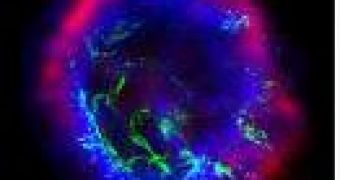The earliest recorded supernova, SN 185, was viewed by Chinese astronomers in 185 AD. Modern day scientists think they have pretty much figured its formation mechanisms.
But recently-observed supernova is making some astrophysicists doubt prevailing theories for how stars die.
The massive star, located in galaxy UGC 4904 about 77 million light-years from Earth in the constellation Lynx, threw off a huge amount of material on October 20, 2004. This star, which may have been what's known as a Luminous Blue Variable (LBV), was mistaken for a supernova, as LBVs often are. In fact, some observers refer to them as "supernova impostors."
Then, in the fall of 2006, the star exploded into a full supernova, much sooner than expected. Dubbed Supernova 2006jc, the dying star's blast wave apparently reached the shell of drifting material released in the earlier outburst in mere hours.
The wave heated the ejected gases to millions of degrees, sparking X-ray emissions of an intensity and duration never before detected. NASA's Swift satellite recorded X-rays brightening from the supernova for an unprecedented 100 days. All previously observed supernovae have initially appeared bright in X-rays before quickly turning invisible.
"We have never observed a stellar outburst and then later seen the star explode," said astronomer Ryan Foley.
Using the 10-meter (32.8-foot) Keck telescope in Hawaii, his group observed narrow helium spectral lines that showed that the supernova's blast wave ran into a slow-moving shell of material, presumed to be the upper layers of the star ejected two years earlier. Had the supernova's fast-moving blast wave been measured unobstructed, its spectral lines would have been much broader.
"It disrupts our current model of stellar evolution," Foley said. "We really don't know what caused this star to have such a large eruption so soon before it went supernova."
"The fact that we have no well-established theory for what actually causes these outbursts is the elephant in the living room that nobody is talking about," said Foley's colleague, Nathan Smith.

 14 DAY TRIAL //
14 DAY TRIAL //